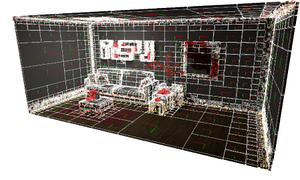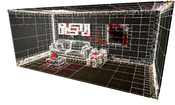Information
- Publication Type: Conference Paper
- Workgroup(s)/Project(s):
- Date: May 2020
- Lecturer: Bernhard Kerbl
- Event: I3D ’20
- Call for Papers: Call for Paper
- Booktitle: Symposium on Interactive 3D Graphics and Games
- Pages: 1 – 9
Abstract
With the introduction of hardware-supported ray tracing and deep learning for denoising, computer graphics has made a considerable step toward real-time global illumination. In this work, we present an alternative global illumination method: The stochastic substitute tree (SST), a hierarchical structure inspired by lightcuts with light probability distributions as inner nodes. Our approach distributes virtual point lights (VPLs) in every frame and efficiently constructs the SST over those lights by clustering according to Morton codes. Global illumination is approximated by sampling the SST and considers the BRDF at the hit location as well as the SST nodes’ intensities for importance sampling directly from inner nodes of the tree. To remove the introduced Monte Carlo noise, we use a recurrent autoencoder. In combination with temporal filtering, we deliver real-time global illumination for complex scenes with challenging light distributions.Additional Files and Images
Weblinks
BibTeX
@inproceedings{tatzgern-2020-sst,
title = "Stochastic Substitute Trees for Real-Time Global
Illumination",
author = "Wolfgang Tatzgern and Benedikt Mayr and Bernhard Kerbl and
Markus Steinberger",
year = "2020",
abstract = "With the introduction of hardware-supported ray tracing and
deep learning for denoising, computer graphics has made a
considerable step toward real-time global illumination. In
this work, we present an alternative global illumination
method: The stochastic substitute tree (SST), a hierarchical
structure inspired by lightcuts with light probability
distributions as inner nodes. Our approach distributes
virtual point lights (VPLs) in every frame and efficiently
constructs the SST over those lights by clustering according
to Morton codes. Global illumination is approximated by
sampling the SST and considers the BRDF at the hit location
as well as the SST nodes’ intensities for importance
sampling directly from inner nodes of the tree. To remove
the introduced Monte Carlo noise, we use a recurrent
autoencoder. In combination with temporal filtering, we
deliver real-time global illumination for complex scenes
with challenging light distributions.",
month = may,
event = "I3D ’20",
booktitle = "Symposium on Interactive 3D Graphics and Games",
pages = "1--9",
URL = "https://www.cg.tuwien.ac.at/research/publications/2020/tatzgern-2020-sst/",
}


